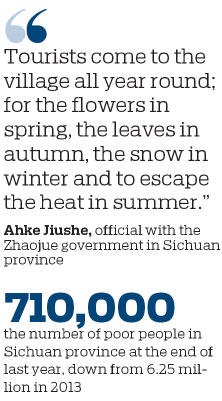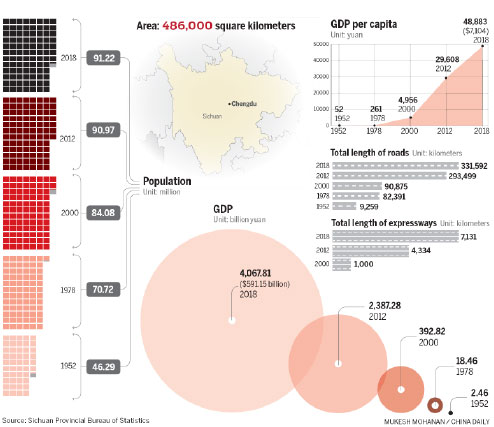Tourism helps villagers climb out of poverty
Cliff-top outpost shows other poor rural areas how attracting visitors can kick-start development
Editor's Note: As the People's Republic of China prepares to celebrate its 70th anniversary on Oct 1, China Daily is featuring a series of stories on the role regions have played in the country's development and where they are today.
A cliff-top village which was until recently only accessible by climbing 800 meters of precarious, dangling rattan ladders, has become a major tourist attraction in Sichuan province.
Tourists from across the province flock to Atuleer village, Zhaojue county, Liangshan Yi autonomous prefecture to see the rattan ladders. Sometimes they even try to climb them. The cool climate of the village, which is home to 500 people, also attracts visitors trying to escape the worst of the summer heat.
Ahke Jiushe, an official with the Zhaojue government, said Atuleer, once impoverished and barely known to the outside world until several years ago, now boasts a hotel with Wi-Fi as well as hot water for guests to shower.

"Tourists come to the village all year round; for the flowers in spring, the leaves in autumn, the snow in winter and to escape the heat in summer," Ahke said.
Life in the "cliff village" garnered nationwide attention in 2016 when a Chinese newspaper published a collection of photos featuring students scaling the 1,400 meter cliff via the rattan ladders.
When residents refused to leave the site despite the difficulties of living there, the local government spent 1 million yuan ($145,400) to add a steel ladder with a handrail that has cut travel time to the nearest town from three hours to one.
China Telecom followed with an investment of 1.5 million yuan to bring cellphone service and the internet to the villagers.
Interest from tourists has encouraged a company in the provincial capital of Chengdu to invest in the wider region, which is home to canyons, karst caves, hot springs and primitive forests.
Homestay plans
The prospect of rural areas being developed for tourism has been noticed by both the Ministry of Culture and Tourism and the National Development and Reform Commission.
A conference on rural tourism held on Sunday in Chengdu was told homestay accommodation in the countryside would play an important role in the transformation and upgrading of rural tourism, Xinhua reported.
Countryside homestays should adhere to the village's characteristics and not be clones of a city hotel or developed for "agricultural entertainment", according to ministry officials. They should also cater to the needs of the average traveller instead of high-end tourists, which deviates from the purpose of homestays.
Under a plan to provide special financial support, China Agricultural Bank will provide a 100 billion yuan credit to the nation's key rural tourism villages over the next five years.
Tourist visits to rural areas reached 1.51 billion in the first half of this year, an increase of 10.2 percent year-on-year, while the total income from rural tourism stood at 860 billion yuan, an 11.7 percent increase over the same period last year.
The total number of people employed in rural tourism in China reached 8.86 million by the end of June, an increase of 7.6 percent year-on-year.
Tailored policies
Changes in Atuleer village are in a line with discussion President Xi Jinping had on March 8, 2017, with delegates from Sichuan during the annual National People's Congress session in Beijing.
Having learned about the difficult lives of residents, Xi told the delegates that poverty reduction requires tailored policies and precise measures, and sometimes patience and meticulous accuracy - like "doing embroidery".
Using such measures, Sichuan reduced its number of poor people from 6.25 million in 2013 to 710,000 at the end of last year.
"As one of the main battlefields for poverty reduction, Sichuan was one of the provinces with many poor people in 2013," said Peng Qinghua, secretary of the Sichuan Provincial Committee of the Communist Party of China.
Thanks to the targeted measures, it has since reduced the number of poor people by 1.1 million a year on average, Peng said.
Nanjiang county, which belongs to the Qinling-Dabashan Mountain Area, a key area for poverty alleviation identified by the Central government, has benefited from policies aimed at improving the road network and promoting locally produced agricultural goods.
Nanjiang has given priority to infrastructure construction, building paved roads that crisscross the county.
He Bo, an officer with the county government information office, said it now has 5,435 km of paved roads, with 94 percent of them in the countryside, and every village is now connected by one.
Ninety-five percent of the land in Nanjiang is mountainous and the improved roads have facilitated the sales of local products like walnuts, selenium tea and honeysuckle to the outside world, while raising farmers' incomes.
Walnuts from Nanjiang, renowned for having 22 mineral elements, thin shells and a meaty pulp, are in high demand. Such are Nanjiang walnuts' reputation for quality, that sellers certify their origin.
The county's soil is rich in selenium, a trace element with antioxidant properties and Nanjiang produces around 3 million kilograms of selenium tea a year.
The county's honeysuckle, which is said to reduce heat and clear toxins from the body, has also obtained geographic certification.
The Institute of Political Science of the Chinese Academy of Social Sciences last year hailed the county's green development as a role model for 74 other counties and districts in the less-developed Qinling-Dabashan Mountain Area, as well as for most other mountain communities across the country.
The per capita disposable income of its 700,000 residents rose from 131 yuan in 1978 to nearly 16,890 yuan in 2017.
Xinhua contributed to this story.
huangzhiling@chinadaily.com.cn

|
People climb to Atuleer village in Zhaojue county, Sichuan province, along a steel ladder with a handrail.Xinhua |
(China Daily Global 08/08/2019 page4)



















